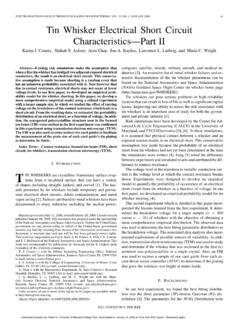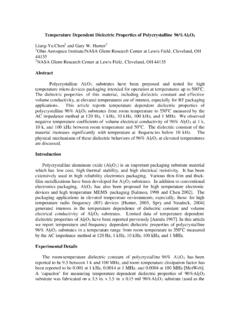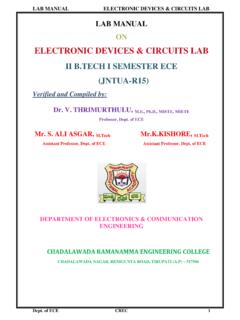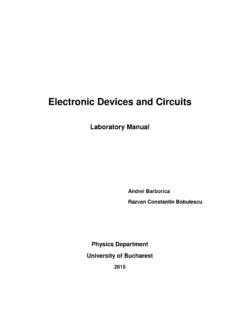Transcription of Photonic Integrated Circuit (PIC) Device Structures ...
1 Deliverable to NASA electronic Parts and Packaging (NEPP) Program to be published on _____ Title: Photonic Integrated Circuit (PIC) Device Structures : Background, Fabrication Ecosystem, Relevance to Space Systems Applications, and Discussion of Related Radiation Effects Author: Shannon Alt, Author Jonathan Pellish, Technical Management NASA electronic Parts and Packaging (NEPP) Program NASA Goddard Space Flight Center Date: April 15th, 2016 _____ BOK Executive Summary: electronic Integrated circuits are considered one of the most significant technological advances of the 20th century, with demonstrated impact in their ability to incorporate successively higher numbers transistors and construct electronic devices onto a single CMOS chip. Photonic Integrated circuits (PICs) exist as the optical analog to Integrated circuits; however, in place of transistors, PICs consist of numerous scaled optical components, including such building-block Structures as waveguides, MMIs, lasers, and optical ring resonators.
2 The ability to construct electronic and Photonic components on a single microsystems platform offers transformative potential for the development of technologies in fields including communications, biomedical Device development, autonomous navigation, and chemical and atmospheric sensing. Developing on-chip systems that provide new avenues for integration and replacement of bulk optical and electro-optic components also reduces size, weight, power and cost (SWaP-C) limitations, which are important in the selection of instrumentation for specific flight projects. The number of applications currently emerging for complex photonics systems particularly in data communications warrants additional investigations when considering reliability for space systems development. This Body of Knowledge document seeks to provide an overview of existing Integrated photonics architectures; the current state of design, development, and fabrication ecosystems in the United States and Europe; and potential space applications, with emphasis given to associated radiation effects and reliability.
3 1 Deliverable to NASA electronic Parts and Packaging (NEPP) Program to be published on Table of Contents: _____ I. Background: Integrated Photonic 2 a. Background and Primary Advantages Offered by Integrated Photonics 2 b. Materials used in Integrated Photonics devices 2 c. Structural Building Blocks 4 II. Design and Fabrication 6 a. Fabrication: Existing Foundry Ecosystems 6 i. JePPIX Infrastructure: Indium Phosphide/TriPleX 7 ii. Existing Foundry Processes for Silicon Photonics and the Announcement of the Integrated Photonics Institute for Manufacturing Innovation 8 b.
4 Modeling, Simulation, and Design Techniques 9 c. Sophisticated Commercial Technologies 13 III. Space System Applications for Integrated 15 a. Sensing 16 b. Biological Applications 17 c. Communications 18 d. Autonomous Navigation/Positioning 19 e. Imaging 20 IV. Radiation Effects: Developing Reliable Photonic Integrated Circuits for Space-Systems 21 2 Deliverable to NASA electronic Parts and Packaging (NEPP) Program to be published on I.
5 Background: Photonic Integrated Circuits a. Background and Primary Advantages offered by Integrated Photonics The invention of the transistor and subsequent advent of Integrated circuits technology is widely considered to be one of the most significant discoveries of the 20th century. In 1958, the monolithic Integrated Circuit was developed at Texas Instruments to replace previous time-intensive methods of hand-soldering discrete elements1. Since these initial innovations in the late 1950s and 1960s, the progress and development of semiconductor industries has experienced continued rapid growth, with Moore s Law describing a doubling in the number of transistors achievable on Integrated circuits every two years. The idea of an optical equivalent to Integrated electronic circuits Integrated optics was first proposed by Stewart Miller of Bell Labs in 19692, who suggested that a complex patterns of optical wave circuits, whose communication function might be somewhat analogous to that of lower frequency Integrated circuits, could be fabricated in a sheet of dielectric using photolithographic techniques.
6 The idea of using Integrated photonics to scale multiple optical components on a single monolithic chip offers significant advantages for use in computing and communications systems. As bandwidth requirements continue to increase for communication amongst electronic devices in data centers, problems associated with loss, dispersion, and cross-talk become pronounced in conventional copper channels3. Initial interest in Integrated photonics has been particularly concentrated on the realization of optical interconnects for data centers using vertical-cavity surface-emitting laser technologies4. Advantages pertaining to the use of photonics in communications systems include larger bandwidths than those achievable with electronic systems (on the order of 10-100 THz), minimal loss and electromagnetic interference, lower required powers, and potential improvements in security5. Early advances in Integrated photonics recognized that micron-scale waveguides could be fabricated using existing CMOS process, even with substantial differences in refractive indices of silicon and silicon dioxide required.
7 The promise of scalable existing manufacturing techniques and the potential integration with silicon electronics motivated growth of commercial Integrated photonics companies in the late 1990s and early 2000s6. Since this time, the development of Integrated photonics circuits has been characterized by impressive demonstrations, such as the establishment of active on-chip components including amplifiers and lasers, and the development of robust 500 GB/s transmitter and receiver Photonic Integrated Circuit modules7. The possible applications for Photonic Integrated circuits (PICs) using silicon and other materials platforms, such as compound semiconductors, extend beyond telecommunications for possible use in disposable high resolution biosensors, optical storage, displays, and sensing for navigation/positioning purposes. Early efforts to investigate the potential of Integrated photonics for space-systems applications appear promising with respect to radiation hardness; to date, radiation tests of Integrated photonics devices at anticipated dose levels for space missions have not affected Device performance, for both silicon and indium phosphide material platforms.
8 B. Materials used in Integrated Photonics devices As with Integrated electronic circuits, there have been long-standing debates whether to broadly develop manufacturing systems for Photonic Integrated circuits on silicon (Si), indium phosphide (InP), or 1 R. Wlaer. (1992). Silicon Destiny: The Story of Application Specific Integrated Circuits. Milpitas: CMC Publications. 2 S. Miller. (1969). Integrated Optics: An Introduction. The Bell System: Technical Journal, 48 (7), pp. 2059-2069. 3 S. Fathpour and B. Jalali. (2012). Silicon Photonics for Telecommunications and Biomedicine. Boca Raton: CRC Press. 4 R. Palmer. (2014). Silicon Photonic Modulators for Low-Power Applications. Karlsruhe: KIT Scientific Publishing. 5 A. Foster (2015). Integrated Photonics. Presentation, Johns Hopkins University, Department of Electrical and Computer Engineering. 6 C. Gunn and T. Koch. Silicon Photonics.
9 Optical Fiber Telecommunications VA: Components and Subsystems. Burlington: Elsevier, Inc. 7 J. Pleumeekers, et. al (2014). Manufacturing Profess for InP-based 500 Gb/s Photonic Integrated Circuits. CS Mantech Conference. Available: 3 Deliverable to NASA electronic Parts and Packaging (NEPP) Program to be published on gallium arsenide (GaAs) materials platforms. Photonic Integrated circuits have been fabricated on a wide variety of materials, ranging from standard element semiconductors and compound semiconductors to dielectric materials and nonlinear crystal materials8. Different types of materials possess specific physical properties that may make them more or less preferable for any given individual application in Integrated optics. Examples may include the use of lithium niobate to fabricate low-loss waveguide devices9 or Integrated flexible chalcogenide glass to make Photonic crystals with mechanical flexibility10. However, to date, the largest financial investments that have been directed towards standardization of materials in fabrication ecosystems have been primarily focused on silicon and indium phosphide Photonic Integrated circuits.
10 The use of silicon (Si) for Integrated photonics offers the advantage of existing mature CMOS fabrication technologies and compatibility with CMOS-based electronics. The ubiquitous use of CMOS technologies for Integrated electronics means that existing fabrication capabilities can provide reliable, high-volume manufacturing techniques with exceptionally high levels of precision11. As one of the most abundant elements on Earth, silicon may be used for the development of devices on-chip that are able to replace previous bulk functions and deliver improvements in both size and cost12. A broad array of on-chip optical components have been fabricated using silicon substrates, including a significant number of waveguide-based devices , such as individual channel waveguides, ring resonators, and Mach-Zehnder Structures , which have then been assembled to produce more complex Integrated Photonic circuits13. Silicon waveguide Structures are effective at guiding light at relevant telecommunications wavelengths, with current propagation losses less than 1 Db/cm.



















